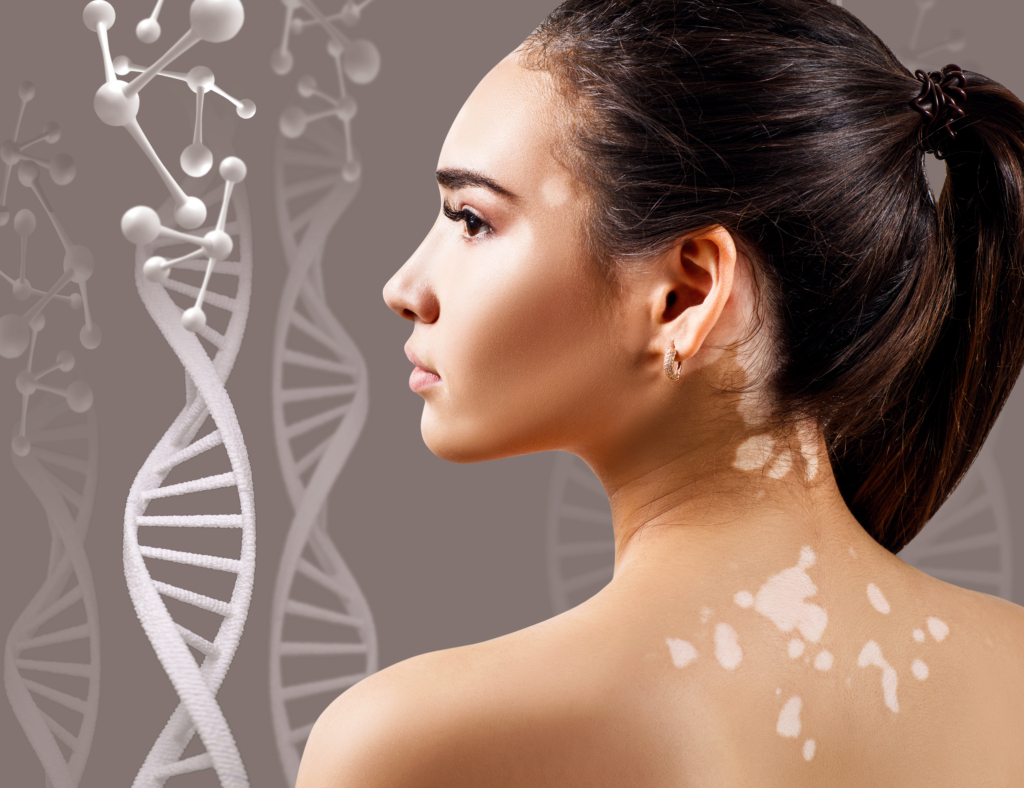Written by Dr. Pradeep
Leucoderma

What is vitiligo?
Vitiligo, also called ‘leucoderma’ is a long-term skin condition that causes an area of the skin to lose its colour (pigmentation), which results in the area looking white or pink in appearance.
Vitiligo can actually appear anywhere on the body, but it’s more likely to develop in some of the following areas:
- Eyes, nostrils, belly button, elbows, and genital areas.
- Occasionally found inside of the mouth.
- Areas of the body that have folds, such as the knees and elbows.
Because pigment cells give colour to hair as well as skin, some people with vitiligo may notice early onset greying of the hair or a loss of colour on the lips.
There is no prejudice in terms of who can develop the condition. Therefore, it can affect anyone, whatever their skin colour or ethnic origin, but will be more visually prominent in those with darker skin. People with fairer skin colour may not even realise that their skin is not making pigment.
Although vitiligo can start at any age, 95% of people who have vitiligo develop the condition before their 40th birthday.
Vitiligo myth-busting
A common question in terms of vitiligo is whether it’s contagious. The short answer is no, you can’t catch it and you certainly can’t pass it on by touching someone.
Still have concerns? Well, here are a couple of other myths that need busting:
- Vitiligo is notlinked to cancer, albinism or leprosy.
- Vitiligo is notan infectious disease.
- Vitiligo is nota physically harmful condition.
Now that we have addressed the myths surrounding vitiligo, let’s move onto some more facts.
Types of vitiligo
There are three known types of vitiligo; they are dependent on how many patches someone has and where they might present on the body:
- Focal vitiligo: Found in patients with a few vitiligo spots in a single area.
- Segmental vitiligo: The most unusual form of vitiligo where patches are generally found on one side of the body and nowhere else.
- Generalised vitiligo (aka non-segmental vitiligo): Found in patients with many patches all over the body. They tend to affect the right and left sides of the body in a symmetrical pattern, almost like a mirror image. This is the most common type of vitiligo and is also known as ‘universal’ or ‘complete’ vitiligo.
What causes vitiligo?
Why vitiligo occurs is not currently known. It is thought to be linked to autoimmune diseases, which result in the immune system attacking its own healthy tissues in error, instead of foreign cells such as viruses or bacteria. The first signs may be in an area of the skin that has received extensive sun damage.
Approximately 15-25% of people with vitiligo may also be affected by one other autoimmune disease such as hyperthyroidism (an overactive thyroid gland), disease, rheumatoid arthritis, type 1 diabetes, psoriasis, pernicious anemia, Addison disease.

Is vitiligo linked to other conditions?
It’s generally thought that around 15 to 25 percent of people who have vitiligo are also affected by at least one other autoimmune condition. Most commonly, type 1 diabetes, autoimmune thyroid disease, rheumatoid arthritis, psoriasis, pernicious anemia, Addison disease, systemic lupus erythematosus, celiac disease, Crohn disease, or ulcerative colitis. Many people with vitiligo also find a correlation between eczema and their patches.
Is there a way to prevent vitiligo?
There is no way you can predict where, when or even if you are going to get vitiligo. And as we don’t know why vitiligo occurs, there is no way it can be prevented. It is thought to be triggered by a combination of genetics and environmental conditions, which can appear at any age. However, it is thought that several factors can contribute to its onset
- Damage to the skin due to critical sunburn or a cut(s).
- Heredity – it may run in families.
- Hormonal changes in the body, for example, adolescence.
- Exposure to some chemicals.
- Liver and/or kidney issues.
Products that contain phenol (also known as carbolic acid or phenic acid) can be possible triggers of vitiligo. These products include
- Adhesives
- Deodorants
- Disinfectants
- Duplicating paper
- Germicidal detergents
- Insecticides
- Latex gloves
- Paints
- Photographic chemicals
- Printing inks
- Soap antioxidants
- Synthetic oils
- Varnish and lacquer resins
Signs or symptoms
It may start as a small white spot that differs from the normal skin tone, but, as time goes on, this spot will become paler until it turns white. How the patches develop are wholly unpredictable. For some, they can develop and expand slowly over time, while for others it will never progress much further than a spot or two. Although rare, in some cases, the patches will develop rapidly. In some exceptionally rare cases some people have even experienced ‘spontaneous re-pigmentation’ of the skin.
There aren’t that many symptoms associated with vitiligo. Some have described an itching sensation caused by skin inflammation, resulting in a slight red tone plus soreness and dryness. One thing to also consider is that although vitiligo symptoms will present both physically and visually they can also affect someone’s emotional wellbeing due to the stress involved with an ongoing condition.
Seeking a diagnosis and what to expect
The best way to know if you have vitiligo is to go and see your doctor. You can even prepare for your visit by doing the following:
- Reviewing your family medical history.
- Making notes concerning any stressful events that have occurred in your life.
- Making a list of chemicals you may have come into contact with.
- Considering taking a friend or family member with you for support.
- Preparing a list of questions to ask your doctor.
During your visit, your doctor will ask several questions concerning various areas of your life including family history and whether you have had any injuries. If available, your patches will be examined using a ‘Woods Lamp’ (ultraviolet lamp) which will assist in narrowing down and eliminating the possibility of it being another skin condition.
Related Procedures

Leg Hair Removal

Loyalty Rewards

Body Hair Removal

Facial Hair Removal

For Dark Skin

Threading

Alexandrite Laser

Electrolysis

